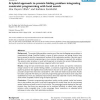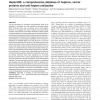262 search results - page 34 / 53 » Retrieval of 3D protein structures |
BMCBI
2010
13 years 11 months ago
2010
Background: The protein folding problem remains one of the most challenging open problems in computational biology. Simplified models in terms of lattice structure and energy func...
JCB
2006
13 years 11 months ago
2006
Protein fold recognition is an important step towards understanding protein three-dimensional structures and their functions. A conditional graphical model, i.e., segmentation con...
ISBI
2002
IEEE
14 years 11 months ago
2002
IEEE
We describe the Protein Subcellular Location Image Database (PSLID), which collects and structures 2-D through 5-D fluorescence microscope images, annotations, and derived feature...
BIOINFORMATICS
2006
13 years 11 months ago
2006
The key requirement for successful immunochemical assay is the availability of antibodies with high specificity and desired affinity. Small molecules, when used as haptens, are no...
JIB
2006
13 years 11 months ago
2006
3D-structures of proteins and potential ligands are the cornerstones of rational drug design. The first brick to build upon is selecting a protein target and finding out whether b...


